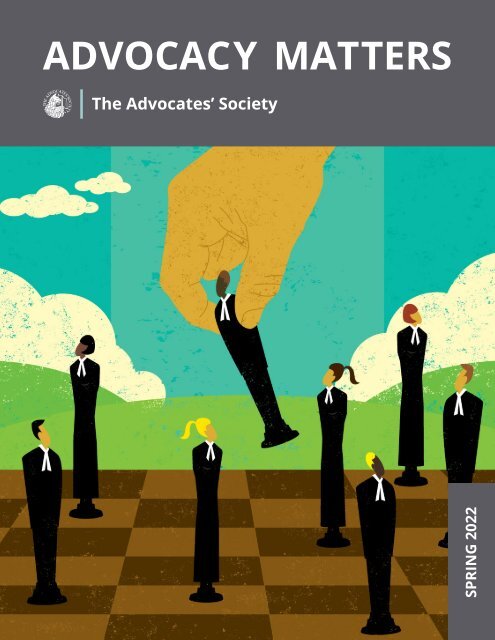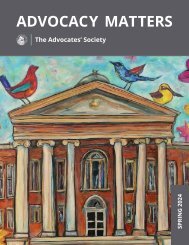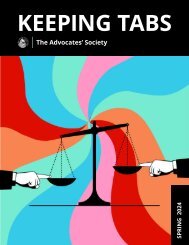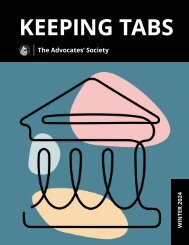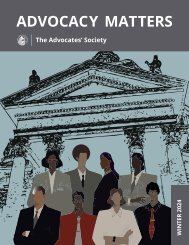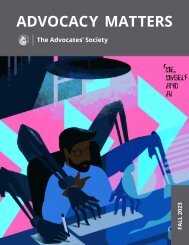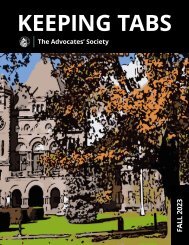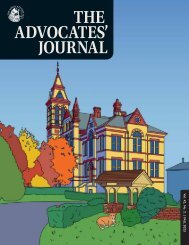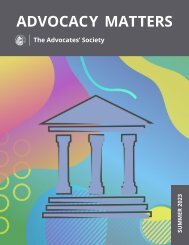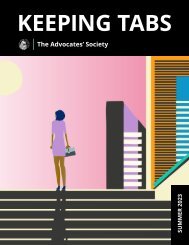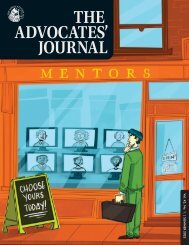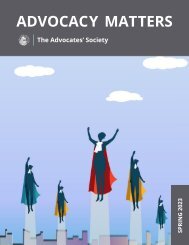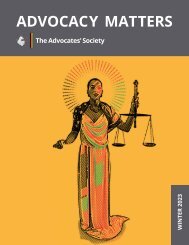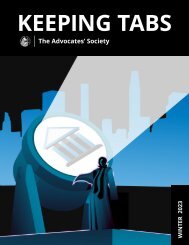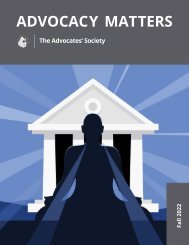Advocacy-Matters-Spring-2022
Keep up to date on what your fellow Society members have to say in Advocacy Matters.
Keep up to date on what your fellow Society members have to say in Advocacy Matters.
Create successful ePaper yourself
Turn your PDF publications into a flip-book with our unique Google optimized e-Paper software.
ADVOCACY MATTERS<br />
The Advocates’ Society<br />
SPRING <strong>2022</strong>
Mastering the art and craft of advocacy is a career-long commitment and we are<br />
here to help. The Advocates’ Society has been the premier provider of advocacy<br />
skills training for over 30 years. We are proud to provide lawyers across Canada<br />
with the training and the confidence they need to execute on their feet when it<br />
counts. The Judge will notice…your clients will too.<br />
Visit www.advocates.ca. Be part of the legacy of extraordinary advocates.
What the TWEET is this?<br />
When you see this icon, throughout the publication,<br />
click on it to see what members are tweeting about.<br />
CONTENTS<br />
05<br />
06<br />
10<br />
12<br />
14<br />
24<br />
Chair Chat<br />
Emily Lawrence, Paliare Roland Rosenberg Rothstein LLP<br />
Cultural Competency, Implicit Bias, and the<br />
Assessment of Credibility<br />
Michelle Alton<br />
Bold Moves in Uncertain Times:<br />
10+ Advocates share their experiences of<br />
making big career changes<br />
Zoe Oxaal, Department of Justice<br />
Word to the Wise: Moneyball for Legal Mentors<br />
Megan Keenberg, Van Kralingen & Keenberg LLP<br />
Art in our Offices<br />
Tamara Ramsey, Dale & Lessmann LLP<br />
Interview with Brian Duong,<br />
Hunter Litigation Chambers<br />
Compiled by Miranda Spence, Aird & Berlis LLP<br />
Editor: Tamara Ramsey, Dale & Lessmann LLP<br />
The opinions expressed by individual authors are their own and do not necessarily reflect the policies of The Advocates’ Society.<br />
<strong>Advocacy</strong> <strong>Matters</strong> Editorial Team: Michelle Alton, Tribunal General Counsel, Daniel Baum, Langlois Avocats, Megan Keenberg, Van Kralingen &<br />
Keenberg LLP, Ayesha Laldin, Department of Justice Canada, Ontario Regional Office, Zoe Oxaal, Department of Justice, Canada, Civil Litigation Section,<br />
Miranda Spence, Aird & Berlis LLP, Christine Vanderschoot, Vanderschoot Family Law<br />
3
CHOOSE FROM CANADA’S TOP<br />
MEDIATORS AND ARBITRATORS<br />
Carol A. Albert<br />
J.D., LL.M. (ADR)<br />
Retired Construction Lien Master, SCJ<br />
Carol’s areas of expertise include<br />
construction, landlord and tenant<br />
and municipal law. She is<br />
particularly qualified to case<br />
manage civil actions, and to hear<br />
motions and conduct arbitrations<br />
and references under the<br />
Construction Act.<br />
Leslie Dizgun<br />
M.A., LL.M., C.Med.<br />
Leslie’s areas of expertise include<br />
corporate/commercial, defamation,<br />
wrongful dismissal, human rights,<br />
condominium, franchise and real<br />
estate disputes. He teaches Dispute<br />
Settlement in the Civil Justice<br />
System at Osgoode Hall Law School<br />
and is a highly regarded speaker<br />
and instructor.<br />
2021-22<br />
2021-22<br />
READERS’<br />
CHOICE<br />
ADR & MEDIATION CHAMBERS<br />
416.362.8555 • 1.800.856.5154 • booking@adr.ca • adrchambers.com
CHAIR CHAT<br />
Chair Chat<br />
Emily Lawrence,<br />
Paliare Roland Rosenberg Rothstein LLP<br />
As I write my final Chair Chat of my term as<br />
Chair of the 10+ Committee, my neighbourhood<br />
– where I am still working much of the time – is<br />
bustling with the beginnings of <strong>Spring</strong>: the fresh<br />
flowers budding, birds chirping, and the sounds<br />
of construction. I am very proud of the work of<br />
the 10+ Committee this year. We have focused<br />
on bringing mid-career advocates from across the<br />
country together for engaging discussions on the<br />
themes of mentorship, running a successful law<br />
firm, and numerous series on current events.<br />
In my first Chair Chat last Summer, I approached<br />
the re-emergence out of pandemic<br />
lockdowns with optimism and some trepidation.<br />
I called for this year to be a time to gather<br />
and renew our connections. Looking back, it<br />
feels this year has been filled with fits and starts<br />
towards a return to pre-pandemic practices,<br />
with a fair number of steps backwards along<br />
the way. Over this year, both in our Committee’s<br />
work and in my conversations with peers and<br />
colleagues, it strikes me that the pandemic has<br />
been a period of deep reflection for many – on<br />
how we want to work and who we want to work<br />
with, how we weigh the practice of law against<br />
other pursuits and obligations, and how our<br />
justice system serves (and too often, fails) those<br />
who interact with it. Our recent session on Bold<br />
Moves in Uncertain Times, summarized by Zoe<br />
Oxaal in this edition, is one such example.<br />
Seasons of reflection and transition bring the<br />
opportunity for lasting structural change on<br />
issues that have long needed overhaul. How<br />
do we build inclusive communities, and retain<br />
and elevate women and historically excluded<br />
communities to leadership positions in our<br />
workplaces, the bench, and the broader legal<br />
community? How can we provide meaningful<br />
mentorship across generational and other differences,<br />
especially when many of us continue<br />
to work from home part of the time? How can<br />
advocates leverage their privileged position to<br />
create positive social change? As we emerge<br />
from lock-downs, home-schooling, and lawyering-from-home,<br />
I hope that we will continue to<br />
share our experiences, our insights, and most<br />
importantly our blind spots and mistakes, as we<br />
wrestle with these and other important issues.<br />
I am very proud of the work of the 10+ Committee<br />
this year and feel very privileged to have led<br />
such a creative, insightful and engaged group.<br />
I am also immensely grateful to my co-executive<br />
members, incoming Chair Chloe Snider, incoming<br />
Vice-Chair Steven Frankel and incoming<br />
Secretary Sonu Dhanju-Dhillon. I know they are<br />
ready for the challenge of maintaining and expanding<br />
the offerings of the Committee in the<br />
coming year. I look forward to seeing some of<br />
you in-person at End of Term, and I wish you a<br />
safe and restorative summer.<br />
5
CULTURAL COMPETENCY<br />
Cultural Competency,<br />
Implicit Bias, and the<br />
Assessment of Credibility<br />
Michelle Alton<br />
The assessment of a witness’s credibility is recognized as being particularly difficult. As our<br />
understanding of what it means to be culturally competent develops, and the relationship between<br />
implicit bias and decision-making is further explored, it will be necessary to re-examine<br />
many foundational aspects of our justice system. This article provides a high-level discussion<br />
of how the assessment of credibility may benefit from a more focused examination from a<br />
culturally competent lens.<br />
Cultural Competency and Implicit Bias<br />
The term “cultural competency” is often used to refer to the skills, behaviours, attitudes, and knowledge<br />
that enables professionals to deliver services that are appropriate to a diverse range of clients. 1<br />
6
help break the link between implicit bias and<br />
decision-making include:<br />
• Providing training on implicit bias and cultural<br />
competency to promote awareness of the<br />
prevalence and impact of implicit biases;<br />
• Altering decision-making conditions and<br />
encouraging the use of scripts, checklists,<br />
and other tools to encourage more deliberative<br />
decision-making; and<br />
• Requiring the provision of written reasons. 7<br />
Historically, cultural competency training has<br />
been outward focused, striving to increase an<br />
individual’s understanding about different cultures<br />
and teaching the best ways for this culturally<br />
specific knowledge to be deployed. More recently,<br />
cultural competency training has evolved<br />
to focus on critical self-reflection, particularly<br />
with respect to one’s own implicit biases. 2<br />
There is a growing body of research that supports<br />
a link between implicit bias and intuitive decision-making.<br />
3 Although implicit bias is not necessarily<br />
negative in every circumstance, 4 in the<br />
specific context of judicial decision-making, intuition<br />
has been identified as the “chief source” of<br />
unwanted influences affecting decisions. 5 Intuitive<br />
decision-making also risks decisions being made<br />
without an assessment of all relevant information.<br />
While studies have shown that everyone, even<br />
judges, have implicit biases, research has also<br />
illustrated that steps can be taken to reduce or<br />
even eliminate the undesirable influence of intuition<br />
on decision-making. 6<br />
Some of the actions that have been shown to<br />
Assessing Credibility in a<br />
Culturally Competent Manner<br />
Assessing a witness’s credibility is often described<br />
as the most difficult task required of<br />
a decision-maker, particularly when the testimony<br />
of witnesses is diametrically opposed or<br />
there are cultural aspects to consider. 8<br />
The assessment of credibility has been recognized<br />
to be a highly individualistic exercise<br />
that is dependent on “intangibles”. 9 This is partly<br />
why it can be difficult for judges to articulate<br />
with precision the complex intermingling of<br />
their impressions after listening to and watching<br />
witnesses. 10 It is also these characteristics<br />
that in part explain why appellate courts generally<br />
defer to a trial judge’s credibility findings.<br />
However, it is also these qualities that make the<br />
assessment of credibility particularly vulnerable<br />
to the influence of implicit biases.<br />
Courts have stressed that any assessment of<br />
credibility must avoid reliance on stereotypical<br />
impressions. 11 Like other parts of decision-making,<br />
the assessment of credibility can also be<br />
improved by taking direct action to promote<br />
deliberative decision-making.<br />
Two aspects of the assessment of credibility that<br />
could specifically benefit from a focused examination<br />
from a culturally competent manner are:<br />
• The assessment of the reasonableness or<br />
plausibility of a witness’s testimony. Often,<br />
the reasonableness of a witness’s testimony<br />
is evaluated with reference to the perspective<br />
of a “practical and informed person.” 12<br />
However, as our understanding of implicit<br />
7
iases develops, it is important to critically<br />
assess the perspective being relied upon to<br />
inform this evaluation, including any personal<br />
assumptions or cultural factors which<br />
might impact the assessment in a particular<br />
situation. A focus on more deliberative decision-making,<br />
including ensuring that all the<br />
relevant information is obtained, can also<br />
help lessen the impact of any unwanted influences<br />
when evaluating plausibility.<br />
• The role of demeanour evidence. A trial<br />
judge’s findings on credibility are shown<br />
deference at least in part because the trial<br />
judge has the “overwhelming advantage”<br />
of seeing and hearing witnesses. 13 However,<br />
there is also a growing and consistent<br />
appreciation of the potential unreliability<br />
of demeanour evidence. Specifically, it has<br />
been recognized that an assessment of<br />
credibility based on demeanour can be affected<br />
by several factors, including the culture<br />
of the witness, stereotypical attitudes,<br />
and the pressure and artificiality associated<br />
with testifying in a courtroom. 14 In light<br />
of these concerns, many decision-makers<br />
have advised that demeanour evidence<br />
should be approached cautiously. 15<br />
As our understanding of implicit bias and its<br />
impact on decision-making grows, it is likely time<br />
to re-consider whether it is necessary to rely on<br />
demeanour evidence at all when assessing credibility.<br />
This assessment will require examination<br />
of how decision-makers actually use demeanour<br />
evidence in their decision-making, as well as consideration<br />
of the potential implications of rejecting<br />
reliance on this type of evidence.<br />
The Role of Advocates<br />
As the cultural competency of individuals within<br />
the justice system evolves, all members of<br />
the justice system will have important roles to<br />
play to support the required response to these<br />
changing societal norms and values. For advocates,<br />
the issue of how to best assess credibility<br />
in a culturally competent manner presents an<br />
opportunity for opposing counsel to work together<br />
to provide the court with the best information<br />
available to consider these issues.<br />
For a more in-depth look at this topic, please<br />
see, Michelle Alton, “The Evolution of Impartiality<br />
and the Need for Cultural Competency when Assessing<br />
Credibility”, 35 Canadian Journal of Administrative<br />
Law & Practice 51 (March <strong>2022</strong>).<br />
Notes<br />
1. Pooja Parmar, “Reconciliation and Ethical Lawyering: Some<br />
Thoughts on Cultural Competence,” (2019) 97-3 Canadian Bar<br />
Review 526, 2019 CanLIIDocs 3803.<br />
2. Jowsey, T., “Three zones of cultural competency: surface competency,<br />
bias twilight, and the confronting midnight zone,” (2019)<br />
19 BMC Medical Education 306.<br />
3. See for example, Wistrich, Andrew J. and Rachlinski, Jeffrey John,<br />
Implicit Bias in Judicial Decision Making How It Affects Judgment<br />
and What Judges Can Do About It, Chapter 5 in Sarah E.<br />
Redfield, ed., Enhancing Justice: Reducing Bias (Chicago, Illinois:<br />
ABA Book Publishing, 2017) [Wistrich and Rachlinski]. Intuitive<br />
decision-making operates outside of conscious awareness<br />
and involves relying upon one’s first instinct, producing rapid,<br />
effortless, and confident judgments. In contrast, deliberative<br />
decision-making is of a higher order and is slower and more<br />
conscious – see Wistrich and Rachlinski, at p. 90.<br />
4. See Anona Su, “A Proposal to Properly Address Implicit Bias in the<br />
Jury”, (2020) 31 Hastings Women’s L.J. 79 at p. 81.<br />
5. Wistrich and Rachlinski at pp. 91. See also Melissa L. Breger,<br />
“Making the Invisible Visible: Exploring Implicit Bias, Judicial Diversity,<br />
and the Bench Trial”, 53 University of Richmond Law<br />
Review 1039 [Breger] at p. 1055.<br />
6. See for example, Wistrich and Rachlinski.<br />
7. Wistrich and Rachlinski at pp. 105 – 119; Breger at p. 1057;<br />
David L. Faigman, Jerry Kang, Mark W. Bennett, Devon W.<br />
Carbado, Pamela Casey, Nilanjana Dasgupta, Rachel D. Godsil,<br />
Anthony G. Greenwarld, Justin D. Levinson, and Jennifer<br />
Mnookin, “Implicit Bias in the Courtroom”, (2012) 59 UCLA L.<br />
Rev. 1124 at p. 1132.<br />
8. R. v. S. (R.D.), 1997 CanLII 324 (SCC) at para. 128 and Shaath v.<br />
Zarifa, 2005 CanLII 25185 (ON SC) at para. 2 and.<br />
9. R. v. S. (R.D.), at para. 128.<br />
10. R. v. Gagnon, 2006 SCC 17 at para. 20, positively quoted in R. v.<br />
G.F., 2021 SCC 20 at para. 81.<br />
11. R. v. Khan, 2019 ONSC 7397 (CanLII) at para. 44.<br />
12. Faryna v. Chorny, 1951 CanLII 252 (BC CA) at p. 357.<br />
13. R. v. N.S., 2012 SCC 72, at para. 25, referencing Housen v. Nikolaisen,<br />
2002 SCC 33, [2002] 2 S.C.R. 235, at para. 24. See also<br />
White v. The King, 1947 CanLII 1 (SCC), at p. 272 and R. v. W. (R.),<br />
1992 CanLII 56 (SCC) at p. 131.<br />
14. R. v. Rhavel, 2015 ONCA 377 (CanLII) at para. 85. See also R. v.<br />
McDougall, 2009 CMAC 2 (CanLII) at para. 44 and R. v. Ramos,<br />
2020 MBCA 111 at paras. 112 and 158.<br />
15. For example, see R. v. Hemsworth, 2016 ONCA 85 CanLII at para. 45.<br />
8
Free Member<br />
Resource<br />
Library<br />
NEW CONTENT NOW AVAILABLE<br />
www.advocates.ca
EVENT REPORT<br />
Bold Moves in<br />
Uncertain Times:<br />
10+ Advocates share their<br />
experiences of making big<br />
career changes<br />
Zoe Oxaal, Department of Justice<br />
10
The 10+ Standing Committee’s Speaker Series<br />
returned with a look at Bold Moves in Uncertain<br />
Times. Three mid-career lawyers, who have each<br />
made bold career moves during the pandemic,<br />
gave candid and up-close insights into the challenges<br />
and rewards of making those changes.<br />
Faren Bogach and Joelle D. Ruskin both left<br />
partnerships at big firms and took the plunge<br />
to open their own firms. Faren launched<br />
Construct Legal, a firm that focuses on legal<br />
advice for construction and infrastructure projects.<br />
The new firm gave her the opportunity<br />
to do business differently, from profit sharing<br />
with associates to “maximum billable hours”<br />
targets. Joelle founded JJ Integrative Family<br />
Law, transforming the environment in which<br />
her family law clients are received in times of<br />
personal crisis, and integrating client mental<br />
health support into her practice.<br />
Jason W.J. Woycheshyn made a bold geographical<br />
move leaving Bay Street for the Atlantic<br />
region to join Stewart McKelvey as a Halifax<br />
partner. His growing family and the desire<br />
to be nearer to close relatives motivated the<br />
change. Professionally, exposure to an entirely<br />
different legal market has proven to be extremely<br />
rewarding.<br />
All three panelists shared advice on managing<br />
the stresses and fears of leaving a well-established<br />
practice to forge a new path. The importance<br />
of preserving relationships with former<br />
colleagues and the feeling of divided loyalties<br />
during the transition was a common theme. “It’ll<br />
never be the perfect time,” recalled Faren, “you<br />
just have to jump”.<br />
Chloe Snider of Dentons Canada moderated<br />
the event and shared these closing words, “Our<br />
panelists reminded us to seek help when we<br />
need it and to believe in ourselves, whether or<br />
not we are looking to make a big move.”<br />
11
MENTORING<br />
Word to the Wise:<br />
Moneyball for Legal Mentors<br />
Megan Keenberg, Van Kralingen & Keenberg LLP<br />
In Moneyball: The Art of Winning an Unfair Game, author Michael Lewis exposed the flawed metrics<br />
of predicting success and assessing player value in Major League Baseball. The central premise of<br />
the book is that the traditional wisdom of baseball insiders was outdated and subjective. A deeper<br />
dive into game statistics revealed differential indicators of success that were largely ignored or<br />
overlooked. The identification of these indicators allowed Billy Beane and the Oakland Athletics to<br />
recruit and foster the talent of undervalued players to gain a competitive advantage. One of those<br />
12
players was Jim Mecir. Mecir walked with a limp.<br />
He was born with a club foot resulting in asymmetry<br />
in the length and strength of his legs. His<br />
unique physique gave him an unconventional<br />
pitching motion that he credits with making his<br />
screwball pitches harder for batters to hit. In<br />
short, the traits that made Mecir a great pitcher<br />
were precisely those that led others to underestimate<br />
his value in professional athletics.<br />
I’ve been thinking about how we as mentors<br />
in the legal profession can apply a Moneyball<br />
lens to reframe the assessment of our<br />
mentees’ skills and traits. Conventional legal<br />
mentoring operates under a conformity-based<br />
apprentice model. In a conformity-based framework,<br />
the things that make us stand out are<br />
often the things that invite criticism and corrective<br />
action. Applying a Moneyball lens, we<br />
might see that the very traits that we identify<br />
for corrective action in our mentees might<br />
just be their superpowers.<br />
Every trait and pattern of conduct has a flip<br />
side that can be viewed as either a strength or<br />
a weakness: tenacious is just another word for<br />
stubborn; “prickly” is another way to say principled.<br />
Consider how that flipside might be mined<br />
for undervalued superpowers in your mentees.<br />
That associate who barely reaches target<br />
hours? Maybe she just works faster than everyone<br />
else. Look at her output, and if it’s comparable<br />
to others with higher billable hours, put her<br />
on fixed fee files to optimize the value of her<br />
speed. The associate who procrastinates and<br />
hands things in at the last minute? She probably<br />
performs admirably under pressure. Help<br />
her find other ways to keep the pressure on as<br />
a motivator without compromising the team’s<br />
time management (e.g., schedule hard internal<br />
deadlines well before the filing deadline). Try to<br />
pinpoint the hidden value in every “flaw” before<br />
you prescribe corrective action – you just might<br />
find a latent superpower in need of fostering.<br />
13
TAS MEMBERS<br />
Art in our Offices<br />
Tamara Ramsey, Dale & Lessmann LLP<br />
Introduction<br />
Art has always been important. Art connects us to the world around us and inspires us in different<br />
ways. While many of us curated our spaces long before COVID-19, being locked out of our offices<br />
and forced onto Zoom prompted us to reflect even more about the space around us. We want our<br />
offices, both at home and in our workplaces, to be spaces where we are happy to work. If possible,<br />
we also want offices to look presentable as digital backgrounds. I personally swapped a piece of<br />
art and a coat rack for the sake of my digital background.<br />
It is a privilege to be able to collect art and hang it in our offices. When we let people into our<br />
office to see our art, we are also sharing something about ourselves, so we thought it would be<br />
fun to ask TAS members to share pictures of art from their offices and to tell us something about<br />
those pieces and what they mean to them<br />
14
Jessyca Greenwood, Greenwood Defence Law<br />
The whimsical world of Anna Valdez is vibrant, detailed<br />
and beautiful. Her art provides inspiration and brings a<br />
piece of California sun to my workspace daily. This piece,<br />
Natural Curiosities, showcases Anna’s technical skills<br />
and has all of the elements we know and love in her<br />
work. My favourite element is the sketch of the painting<br />
within the painting, a small detail not to be missed.<br />
Megan Keenberg,<br />
Van Kralingen & Keenberg LLP<br />
“Honest Abe” by Antony Zito,<br />
New York City, c. 2007. Antony<br />
Zito is a New York artist<br />
and cultural icon. We became<br />
close friends when I lived there<br />
and remain so today. I’ve nicknamed<br />
the piece “Discourage<br />
Litigation” as a hat tip to Lincoln’s<br />
famous quote, and a<br />
cheeky nod to my dual identity<br />
as a Commercial Litigator and<br />
Arbitrator/ Mediator.<br />
15
16<br />
Elizabeth Dipchand, Dipchand LLP<br />
Creativity, inspiration and people is what we had in mind when we designed<br />
our space because the effect of our environment has such a profound<br />
impact on our wellbeing and facilitates excellence. Life is too short to be<br />
surrounded by industrial carpet and beige walls.
Andrew Winton,<br />
Lax O’Sullivan Lisus Gottlieb LLP<br />
Among other things, Tom Chitty<br />
draws portraits of people’s houses. I<br />
commissioned him to draw our family’s<br />
first house a few years before we tore<br />
it down and replaced it with something<br />
new (construction during COVID – that’s<br />
another story)! Two of my three boys<br />
were born in this house. When I look<br />
at this drawing, it reminds me of when<br />
my three boys were much younger and<br />
always out on the driveway playing one<br />
sport or another.<br />
17
Deborah E. Palter,<br />
Thornton Grout Finnigan LLP<br />
“The Argument” by P.H. Palter, Cornwall,<br />
ON, c. early 1970s. The artist is my father<br />
who painted this abstract during a turbulent<br />
period and who instilled in me a passion for<br />
advocacy. It reminds me of the need to fight<br />
for the things that matter, but to remain<br />
careful about when and how.<br />
Sana Halwani, Lenczner Slaght<br />
Commemorative stamps celebrating<br />
the photographer Yousuf Karsh (a<br />
gift from my father). Karsh came to<br />
Canada as a refugee and survivor of<br />
the Armenian genocide. The sheet<br />
features his 1956 portrait of Audrey<br />
Hepburn, his 1941 portrait of Winston<br />
Churchill, and a self-portrait.<br />
18
Karey Brooks, JFK Law<br />
This piece was a commissioned gift. It<br />
lifts my mood every time I look at it. The<br />
talented artist is Rande Cook from Kwakwaka’wakw<br />
in Alert Bay. You can find<br />
more of his amazing work at Fazakas<br />
Gallery and his online shop Leaf Modern.<br />
19
20<br />
Christine Vanderschoot, Vanderschoot Family Law<br />
Gail Hill’s artwork is unique. She combines photography and painting, as<br />
well as her personal wordsmithing. This piece is very personal to me, as<br />
it acts as a mark for me during my career. I first saw the piece hanging in<br />
George restaurant, when I was a “baby lawyer”. Fast forward a few years,<br />
and I was able to join the Verity club affiliated with George. I quickly met<br />
Gail, and we became friends. Gail agreed to create for me a version of<br />
the piece I had admired for years at George. It now hangs in my office,<br />
where I can appreciate it every day.
Jeff Feiner, Corman Feiner LLP<br />
Map of Toronto from 1872 and original seat<br />
back from Massey Hall. I love my hometown<br />
of Toronto. I collect all things Toronto, including<br />
old books about the city. It is a privilege to<br />
be able to live and work here. The art reminds<br />
me that I’m a part of life here, like many others<br />
who came before me.<br />
Jennifer Hunter, Lerners LLP<br />
“Double Fist” and “Sanity is a Cozy<br />
Lie” by Formento + Formento,<br />
a husband and wife team. She<br />
styles and art directs, he lights<br />
and photographs. These are<br />
from a series called Circumstance<br />
(2008-2010), during which they<br />
took a 1 year road trip from New<br />
York to Los Angeles and back,<br />
photographing women they met<br />
along the way. I’ve had them<br />
hanging in my office for more<br />
than 10 years and the expressions<br />
on her face still get me.<br />
21
22<br />
Tamara Ramsey, Dale & Lessmann LLP<br />
The “Power Explodes from Within” by<br />
Marianne Enhörning is one of the first art<br />
pieces I bought for my office. Through a<br />
series of fortunate events, I was able to hang<br />
a gorgeous abstract Tom McNeely painting<br />
in my office. Both pieces bring me joy and<br />
remind me of lessons I learned as a dance<br />
student to simply “be me”.
#TASProud<br />
Congratulations to the TAS leaders appointed to the bench<br />
in 2021/22 to serve the justice system after going above<br />
and beyond to serve our members and the work of TAS.<br />
The Hon. Justice Mahmud Jamal, former TAS Director,<br />
appointed to the Supreme Court of Canada.<br />
The Hon. Justice Lorena K. Harris, former member of the<br />
Alberta Regional Advisory Committee, appointed as a Judge<br />
to the Court of Queen’s Bench of Alberta.<br />
The Hon. Justice Jill R. Presser, former TAS intervention<br />
counsel, appointed as a Judge of the Superior Court of<br />
Justice of Ontario.<br />
The Hon. Justice Colin C.J. Feasby, former member of the<br />
Alberta Regional Advisory Committee, appointed as a Judge<br />
to the Court of Queen’s Bench of Alberta.<br />
The Hon. Justice Jacqueline D. Hughes, former member of<br />
the British Columbia Regional Advisory Committee, appointed<br />
as a Judge to the Supreme Court of British Columbia.<br />
The Hon. Andres C. Garin, former Vice-Chair of the Quebec<br />
Regional Advisory Committee, appointed as a Judge to the<br />
Quebec Superior Court<br />
The Hon. Peter J. Osborne, former TAS Director and Chair<br />
of the Modern <strong>Advocacy</strong> Task Force, appointed as a Judge of<br />
the Superior Court of Justice of Ontario.<br />
The Hon. Robert Centa, longtime TAS skills instructor and<br />
mentor, appointed as a Judge of the Superior Court of<br />
Justice of Ontario.
INTERVIEW<br />
Interview with Brian Duong,<br />
Hunter Litigation Chambers<br />
Compiled by Miranda Spence, Aird & Berlis LLP<br />
Brian Duong maintains a generalist practice in civil and administrative litigation at Hunter<br />
Litigation Chambers in Vancouver.<br />
24
Q. Tell us a little about your practice. What does a typical week look like for you?<br />
A. There is no “typical” week in terms of the kind of work with a generalist litigation practice, which<br />
can be both terrifying and exhilarating. My practice has taken me through a broad range of matters,<br />
including contract and shareholder disputes, property issues (including expropriations and<br />
certificates of pending litigation), franchise litigation, wrongful dismissal claims, municipal bylaw<br />
enforcement, and freedom of information requests. The only real constant is a trip to Starbucks<br />
around 2pm with my colleague Aubin Calvert.<br />
Q. You have had a unique career path. Can you tell us about it?<br />
A. I was recruited as a 3L to Ropes & Gray in Boston for their summer pre-clerk program, before<br />
clerking at the B.C. Court of Appeal. I returned as a litigation associate in 2010. After that, I did<br />
an LLM at Cambridge in International Law from 2012-2013, followed by a Juriste/Associate position<br />
in the International Arbitration Group at Freshfields in Paris. My wife and I lived in Paris<br />
for two years, and our first son was born there. We returned to Vancouver in 2016 to be closer<br />
to family (see: childcare). Upon our move to Vancouver I happily returned to Hunter Litigation<br />
Chambers, where I had articled when my start date in Boston was deferred due to the financial<br />
crisis, and who had graciously allowed me to use their office for independent research before<br />
heading to Cambridge.<br />
Q. What has been your most challenging experience as a lawyer? What did you learn from it?<br />
A. My most challenging experience was transitioning back to practice in Vancouver after so many<br />
years abroad. I certainly felt like I had a lot of catching up to do compared to my peers of the<br />
same vintage. Within the first month, I was thrown into a time sensitive, highly charged property<br />
dispute that had me in the office day and night. During this period, I admittedly had some second<br />
thoughts about whether private practice was the right situation for me. However, it turned out to<br />
be a blessing: I don’t think I’ve ever learned so much about the practice of law in such a short period<br />
of time (approximately 9 months), including with respect to civil procedure, chambers<br />
practice, contract review and issue spotting, effective advocacy and stress management.<br />
And for that I have Ken McEwan, QC to thank.<br />
25
Q. Have you faced discrimination as a racialized lawyer? Do you have any advice for younger<br />
lawyers in this regard?<br />
A. No, I cannot say that I have, certainly not any blatant form of discrimination. That is not to say<br />
that there haven’t been incidents that have given me pause, but it would be tough to pin them<br />
on racial discrimination as opposed to other possible reasons. With respect to stories of discrimination,<br />
stereotyping and bias experienced by members of the Pan-Asian community, I would<br />
encourage all lawyers to watch, and reflect upon, the documentary “But I Look Like a Lawyer” produced<br />
by the BC Chapter of the Federation of Asian Canadian Lawyers (FACL BC): https://faclbc.ca/<br />
documentary. To younger lawyers, I would encourage them to be vigilant and to speak out about<br />
incidents of racial discrimination. In the alternative, to the extent confrontation is not a feasible<br />
course of action, I would encourage younger lawyers to make use of the resources available from<br />
your respective Law Societies. In BC, lawyers can reach out to the Equity Ombudsperson with<br />
respect to concerns about discrimination and discriminatory harassment, and who will receive<br />
inquiries, provide information and discuss options, including possible mediation by consent.<br />
Q. How has the pandemic impacted your practice, positively or negatively?<br />
A. The pandemic has coincided with a progression and expansion of my practice. I made Partner<br />
during the front end of the lockdown, and then found myself largely occupied by the Cullen Inquiry<br />
on Money Laundering, whose hearings were held entirely remotely. The pandemic has forced<br />
me to become more comfortable with both the idea and execution of remote work and remote<br />
hearings. With that all said, I am welcoming (perhaps more so than most others) the transition<br />
back to in-person work. I still firmly believe there is so much more to be gained from working in<br />
the same physical space as your colleagues in terms of work satisfaction, generating ideas, and<br />
building a strong firm culture that remote work can never replace, as nice as it is to roll out of bed<br />
and move to the laptop still in pyjamas.<br />
Q. Most proud moment as a<br />
litigator?<br />
A. If we count law school, I had<br />
the honour of doing the Grand<br />
Moot at the University of Toronto,<br />
with my mom in attendance.<br />
Q. Most embarrassing moment as a litigator?<br />
A. At the cocktail reception after the Grand Moot, my<br />
mom approached Chief Justice Winkler and asked<br />
him why he was so mean to her son. She has not, to<br />
date, come to any of my court appearances.<br />
26
Q. Your key to staying healthy<br />
in a stressful profession?<br />
A. Exercise and<br />
meditation/prayer.<br />
Q. Other than files, name 3 things that are always<br />
on your desk<br />
A. Fountain pens, a notebook, and something my kids<br />
have made for me and insisted that I bring to work.<br />
Q. Favourite vacation spot?<br />
A. I like to go back to the familiar, so Paris and<br />
Boston where I used to live and work.<br />
Q. A food you can’t stand?<br />
A. I had the unfortunate experience<br />
in my youth of mistaking<br />
wasabi for green tea ice cream,<br />
and now I can’t stand even a hint<br />
of wasabi in my food.<br />
Q. Your best advice for young<br />
litigators just starting out?<br />
A. Never underestimate the<br />
power of sitting yourself down<br />
in a colleague’s office to bounce<br />
ideas, vent, celebrate victories or<br />
reflect on setbacks.<br />
27
The Advocates’ Society Annual Gala<br />
April 28, <strong>2022</strong> | Calgary<br />
28<br />
Oliver Ho of Jensen Shawa<br />
Solomon Duguid Hawkes LLP<br />
receives the 2020 Alberta<br />
Excellence in Mentoring Award.<br />
Presented by Melissa Burkett.<br />
Mike Donaldson of Lawson<br />
Lundell LLP receives the<br />
<strong>2022</strong> Alberta Excellence in<br />
Mentoring Award. Presented<br />
by Melissa Burkett.<br />
Master of Ceremonies Doug McGillivray,<br />
Burnet, Duckworth & Palmer LLP
Keynote Speaker: The Honourable Marshall Rothstein, CC QC, Osler, Hoskin & Harcourt LLP<br />
29
Insolvency Group Social<br />
May 17, <strong>2022</strong> | Toronto<br />
Details & Correspondence Calendar & Tasks Financial Summary Time & Fees General Account Trust Funds Safe Custody<br />
Save &<br />
Close<br />
New<br />
Document<br />
New<br />
Email<br />
Forms &<br />
Templates<br />
New<br />
Comment<br />
Import<br />
Share<br />
Document<br />
eSignature<br />
Message<br />
Send<br />
Document<br />
Timesheet<br />
Matter New Correspondence<br />
LawConnect Mobile<br />
Microsoft Teams<br />
Time & Fees<br />
DETAILS<br />
IN PROGRESS<br />
CORRESPONDENCE<br />
Search correspondence<br />
180025<br />
James Stevenson<br />
TYPE ITEM STAFF MODIFIED<br />
Applicant<br />
Ms Sally Penfold<br />
Correspondence<br />
James Stevenson<br />
JS<br />
9:36 AM<br />
Matter type<br />
Property Division<br />
Sally Penfold and Paul Penfold Property..<br />
jharris@email.com<br />
JS<br />
9:32 AM<br />
Respondent<br />
Mr Paul Penfold<br />
Financial Statement<br />
James Stevenson<br />
JS<br />
Apr 2, 2020<br />
Respondent's lawyer<br />
Harris & Jacobs Solicitors<br />
Your Settlement/Property Affairs<br />
jharris@email.com<br />
JS<br />
Mar 29, 2021<br />
Mr Joshua Harris<br />
Trust Statement<br />
JS<br />
Mar 29, 2021<br />
Client correspondence<br />
181 University Ave, Toronto, ON M5H 3M7<br />
Critical fam law details<br />
Costs agreement - Property Settlement<br />
James Stevenson<br />
Letter to Mr Penfold<br />
James Stevenson<br />
JS<br />
JS<br />
Mar 28, 2021<br />
Mar 27, 2021<br />
LEAP is everything you need to run a law firm<br />
Secure Document Management<br />
Cloud Solution & Mobility<br />
Automated Forms<br />
Legal Accounting & Billing<br />
Microsoft Integration<br />
Support & Training<br />
leaplegalsoftware.ca
THE ADVOCATES’ SOCIETY<br />
<strong>2022</strong> END OF TERM DINNER<br />
Thursday, June 23, <strong>2022</strong> | Royal York Hotel | Toronto<br />
Keynote Speaker:<br />
The Hon. Justice Mahmud Jamal,<br />
Supreme Court of Canada<br />
The Advocates' Society is proud to have The Honourable Justice<br />
Mahmud Jamal present the Keynote Address for this event.<br />
Justice Mahmud Jamal was appointed to the Supreme Court of<br />
Canada on July 1, 2021 after serving on the Ontario Court of Appeal<br />
from 2019 to 2021. As a lawyer, Justice Jamal practised in the fields<br />
of appellate litigation, constitutional and public law, class actions,<br />
and commercial litigation. He appeared before the Supreme Court<br />
in civil, constitutional, criminal, and regulatory cases, including<br />
cases involving Quebec civil law. He also appeared before the<br />
courts of seven provinces, the Federal Court, the Federal Court of<br />
Appeal, the Tax Court of Canada, and various federal and provincial<br />
administrative tribunals. He received an undergraduate degree from the University of Toronto and law<br />
degrees from the Faculty of Law of McGill University and Yale Law School. He served as a law clerk<br />
to Justice Melvin L. Rothman of the Quebec Court of Appeal and Justice Charles D. Gonthier of the<br />
Supreme Court of Canada.<br />
A limited number of tickets are still available in the satellite Ballroom at the Royal York Hotel.<br />
Deadline June 9 to book.<br />
Generously Sponsored by:<br />
Cocktail Reception Sponsor<br />
Dinner Wine Sponsor<br />
After-Party Sponsors<br />
Supporter
32<br />
www.advocates.ca


